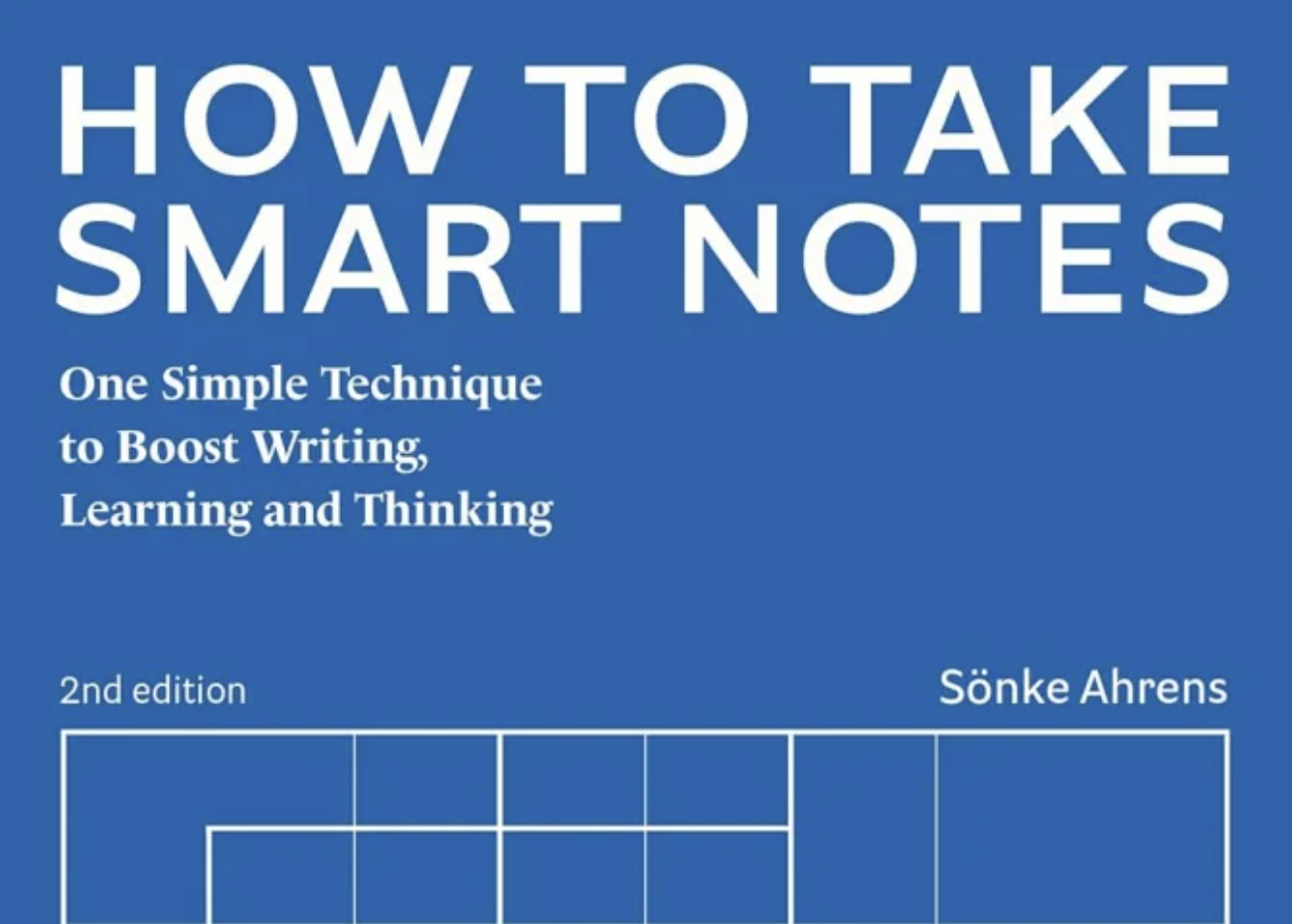How to Take Smart Notes: A Review
Sönke Ahrens' "How to Take Smart Notes" champions the Zettelkasten method, a note-taking approach that boosts your thinking and writing via idea externalization and interconnection. It's fascinating, and fun to use! Check out our review below.

Have you ever felt overwhelmed by the sheer amount of information you consume but struggle to remember? Or perhaps you've sat down to write something important only to face 'blank page syndrome'? I know I have. But then I came upon Sönke Ahrens' book "How to Take Smart Notes". It was a read that was nothing short of revolutionary for my note-taking journey.
My Experience with the Zettelkasten Method
When I first picked up "How to Take Smart Notes," I expected another run-of-the-mill productivity book with the usual advice: organize your notes better, use fancy apps, and create elaborate color-coding systems. What I found instead was a profound examination of how we think, learn, and create knowledge.
Published in 2017, this book introduced English-speaking audiences to the Zettelkasten method—a systematic approach to capturing, processing, and connecting ideas that completely transforms how we think and write. Far from being just another note-taking technique, Ahrens presents a comprehensive framework for intellectual work that addresses the fundamental challenges we face when trying to develop ideas and produce written content.

Who is Sönke Ahrens and Why Should You Care?
Sönke Ahrens isn't just any productivity guru. He's a Lecturer in Philosophy of Education at the University of Duisburg-Essen who coaches students, academics, and professionals in time management and personal growth. His book stands on the shoulders of giants—specifically, the prolific German sociologist Niklas Luhmann.
Luhmann wasn't just academically successful; he was extraordinarily productive, publishing over 70 books and 400 scholarly articles. His secret? A simple yet powerful system of wooden boxes filled with index cards—his "slip-box" (or Zettelkasten in German). This analog system consisted of thousands of handwritten notes linked through a sophisticated referencing system.
What Ahrens does brilliantly is take this proven system and adapt it for contemporary use, explaining not just how it works but why it works on a cognitive level. This isn't just about organizing information—it's about transforming how we think.
The Revolutionary Philosophy Behind Smart Notes
The core insight that changed everything for me was Ahrens' assertion that writing is not separate from thinking—it is thinking. Most of us have been taught that we should think first, then write down our fully formed ideas. Ahrens flips this on its head: "You have to externalize your ideas, you have to write."
This shift in perspective addressed so many of my struggles with intellectual work. I'd often find myself:
- Feeling I didn't have enough ideas worth writing about
- Losing brilliant thoughts because I didn't capture them effectively
- Struggling to see connections between different concepts
- Facing the intimidating blank page when starting new projects
By externalizing my thinking through systematic note-taking, these problems began to disappear. The intimidating blank page became a thing of the past because I was constantly developing ideas, bit by bit, through my notes.

The Three Types of Notes That Will Transform Your Thinking
Implementing the Zettelkasten method starts with understanding the three distinct types of notes that form its foundation:
1. Fleeting Notes: Capturing Ideas in the Wild
These are quick, informal recordings of thoughts or inspirations that pop up throughout my day. I might jot them down on paper, in my phone, or even record a voice memo. The key is that they're temporary—just reminders of what's in my head that I need to process later.
I've found that reviewing these notes within a day or two is crucial. The context is still fresh in my mind, making it easier to decide whether to discard them or transform them into something more permanent.
2. Literature Notes: Active Reading That Sticks
Before discovering Ahrens' system, I'd highlighted passages in books and then promptly forgotten everything I'd read. Now, when I read, I create concise notes capturing the main points I don't want to forget or could use in my own work.
The game-changer here is following four guidelines:
- Being extremely selective about what I keep
- Staying as concise as possible
- Using my own words instead of copying quotes
- Always recording the bibliographic information
This process transforms passive reading into active engagement with the material, dramatically improving my retention and understanding.
3. Permanent Notes: Where the Magic Happens
These are the crown jewels of the system. Created by reviewing and processing my fleeting and literature notes, permanent notes represent my long-term knowledge base. I write them as if addressing someone else—using full sentences, disclosing sources, and striving for clarity and brevity.
Each permanent note contains a single, well-formulated idea that can stand on its own while connecting to other notes. This is where ideas aren't just collected but developed as they become part of an evolving network of interconnected thoughts.

The Smart Note-Taking Process: How I Implement It
The beauty of the Zettelkasten method is its systematic workflow that transforms reading and thinking into a coherent body of interconnected knowledge. Here's how I've implemented it:
- Create fleeting notes throughout the day: Whenever I have a thought or idea, I capture it immediately without worrying about organization or detail.
- Make literature notes while reading: As I encounter meaningful information, I create concise notes capturing the essence in my own words.
- Create permanent notes by reviewing temporary materials: Daily, I review fleeting and literature notes, considering how they relate to my existing knowledge and interests.
- Add permanent notes to my slip-box: I file each note behind a related note or add it to the end if it introduces a new thread. Then I create connections by adding links to and from related notes.
- Develop topics organically: Rather than imposing topics from outside, I let my collection of notes reveal patterns and emerging themes.
- Decide on writing projects based on my notes: Instead of brainstorming topics and facing anxiety, I examine my existing notes to identify areas with sufficient depth.
- Turn notes into drafts: I gather relevant notes, copy them to a separate document, and organize them into a logical structure.
- Edit and refine: With a substantive draft assembled, I focus on polishing the language and ensuring coherence.
This process has completely transformed how I approach writing. What once felt like scaling a mountain now feels like a leisurely stroll through a garden I've been cultivating for weeks or months.

Key Principles That Make This System So Effective
Several core principles underlie the effectiveness of this system:
Atomicity: One Idea, One Note
Each permanent note contains just one distinct thought, allowing it to function as a modular unit within my knowledge system. This approach differs dramatically from traditional note-taking methods like Cornell or Mind Mapping, which often lead to sprawling notes covering multiple topics.
By treating each note as an "atom" of knowledge, I create building blocks that can be recombined in countless ways to generate new insights.
Connection-Making: The Heart of Knowledge Development
In a Zettelkasten, each note must link to at least one other, creating a densely connected network rather than an isolated collection. As Ahrens emphasizes, "the connections are where the magic happens"—it's at these intersections that new insights emerge and creativity flourishes.
Using Your Own Words: The Key to Understanding
Rather than copying information verbatim, I process it through my understanding and express it freshly. This practice forces deeper engagement with the material and facilitates genuine learning.
Personal Orientation: Your Unique Knowledge System
My Zettelkasten represents my unique body of knowledge—not notes taken for communication with others, but a system for making sense of what I learn through personal connections.
Regular Engagement: The Power of Review
Rather than filing away notes and forgetting them, I frequently revisit existing materials when adding new notes. This practice reveals unexpected connections and generates fresh insights.

How I've Implemented This in the Digital Age
While Luhmann used physical index cards, I've adapted the Zettelkasten approach to the digital environment. After trying several applications, I found one that offers three key capabilities:
- The ability to link between notes through hypertext
- Robust search functionality to locate specific notes
- A flexible workspace for temporarily gathering related notes during projects
I've also developed a simple identification system for my notes, enhancing the cross-referencing capabilities central to the method. The digital platform allows me to continuously revise and expand my notes without physical limitations.
Zettelkasten works particularly well with note-taking apps like Obsidian.
The Benefits I've Experienced
Implementing Ahrens' smart note-taking system has transformed my intellectual life in several ways:
No More Writer's Block
By consistently developing ideas through notes, writing has become an "assembly exercise" using material I've already captured and processed. As Ahrens explains, "if we take smarter notes, then there's never any danger of facing a blank screen when we sit down to write."
Deeper Learning and Understanding
The method has improved my learning by transforming passive consumption into active engagement. By articulating ideas in my own words and connecting them to existing knowledge, I've experienced deeper comprehension and more creative application of what I learn.
Organic Development of Ideas and Projects
Rather than imposing arbitrary topics, I let my slip-box reveal emerging patterns and connections. This bottom-up approach ensures that my projects arise from genuine intellectual engagement and sufficient foundation.
A Valuable Personal Knowledge Repository
Unlike project-specific notes that lose relevance upon completion, my Zettelkasten continuously gains value over time as connections multiply and ideas mature. It's become an external thinking partner that reveals unexpected insights.
Reduced Cognitive Load and Increased Focus
By providing a reliable structure for intellectual work, the slip-box reduces cognitive load and creates conditions conducive to flow states. As Ahrens notes, "Good structures set us up to enable Flow—everything else fades away when we trust the structure."
In a Nutshell: Why This Book Changed Everything for Me
"How to Take Smart Notes" presented far more than a method for organizing information—it offered a comprehensive framework for thinking, learning, and creating that addressed fundamental challenges in my daily learning activities.

In our age of information abundance, the ability to process, connect, and develop ideas effectively is increasingly valuable. The Zettelkasten method offers not just a technique but a philosophy for knowledge work that emphasizes quality over quantity, connection over collection, and understanding over mere recording.
As Ahrens eloquently states, "An idea kept private is as good as one you never had." Through the externalization, connection, and development processes at the heart of the Zettelkasten method, I've not only preserved my ideas but allowed them to grow into something far greater than they could ever become within the confines of my mind alone.
If you're struggling with information overload, writer's block, or simply want to take your thinking to the next level, I can't recommend "How to Take Smart Notes" enough. It might just revolutionize your learning journey the way it did mine.

This article contains affiliate links. Clicking on them will help support us at zero cost to our readers. Thank you for helping out, Constant Learners!
